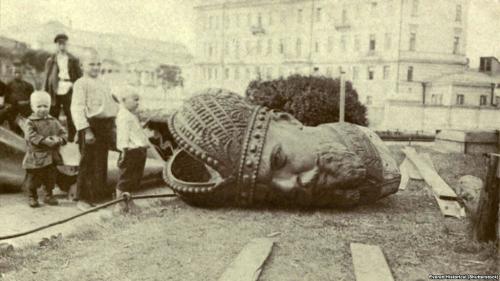
This article by Tommy Martin originally appeared in the Yale Daily News on Nov 10th, 2018.
To commemorate the 100th anniversary of the Bolshevik Revolution, an audience of around 30 people watched Esfir Shub’s “The Fall of the Romanov Dynasty” on Wednesday night.
In an effort to generate conversation about this historical event and its impacts, the Whitney Humanities Center has hosted screenings of various Soviet films this semester. Anastasia Kostina GRD ’21, whose dissertation focuses on Shub’s work, introduced the film, saying that Shub undeservedly receives only limited attention from academics.
“She is arguably one of the most influential women filmmakers from the Soviet Union,” Kostina said.
Shub had a career distinguished by both its diversity and impact. Before the Goskino — the USSR State Committee of Cinematography — hired her as a film director in 1922, she had worked in literature, theater and even a circus production. She spent her first five years with Goskino re-editing foreign films for Soviet screenings. “The Fall of the Romanov Dynasty” was her first independent work. It debuted in 1927 to celebrate the 10th anniversary of the February Revolution, the first outbreaks of dissent that would lead Czar Nicholas II to abdicate. According to John MacKay, professor of Slavic Languages and Literatures and of Film Studies, and an organizer of the series, it also made a significant impact on the documentary field.
Shub played a major role in advancing the style known as compilation film, which relies heavily on historical footage that the director arranges to craft a narrative. Before this became the predominant style, MacKay explained, documentaries were rarely feature length. They resembled newsreel films and were not often major projects.
The silent film is accompanied by live pianist Donald Sosin and immediately transports the audience to its period with grainy, black-and-white footage. In addition, the documentary’s message serves as a valuable artifact of Soviet propaganda.
Although the film contains almost exclusively historical footage, Shub’s directorial presence is evident in the intertitles and editing. She frequently includes air quotes, using irony to criticize life in Czarist Russia.
Juxtaposition also serves a clear and effective purpose in the film. For example, intertitles narrate an aristocratic scene in which nobility dance “until they sweat.” Directly afterward, Shub cuts to laboring serfs, presenting a much different example of sweat.
The middle of the film then focuses on the destruction caused by World War I. The documentary contains mostly neutral shots — stationary and focused on the torso and head of a person or group of people. Yet some of its few panoramic shots depict bodies wasting away on the battlefield. These moments are striking for both their content and sweeping effect, leading the audience to feel the immensity of the price Russian people paid for the war.
The last phase of the movie transitions to February. Workers and soldiers march together into town squares, and here Shub includes film she shot herself. This is limited to newspaper fragments and excerpts from Lenin’s speeches that demonstrate the growing unrest. The movie ends with an image of Lenin waving to a joyous crowd.
Kostina explained that Shub considered original footage vital to the accuracy of both the factual story and the emotional atmosphere of the period. For Shub, she said, “Only through historical documents could the spirit of revolution be captured.”
MacKay explained that one reason the program has paid special attention to film — as opposed to strictly academic lectures put on by professors — stems from the fact that it was designed for a mass audience. Staying true to this theme, a question and answer section follows each screening.
Questions covered everything from stylistic choices to others concerning the historical circumstances. One audience member asked how much Shub herself subscribed to Bolshevik ideology, generating an explanation from Kostina and MacKay about the semantics of propaganda in the Russian language.
Shub’s work remains valuable for both the primary sources it preserves and the glimpse into the Soviet world it offers. Kostina explained that as a constructivist, Shub was committed to using only authentic material to present an authentic story. Yet during a time of numerous “fake news allegations,” someone watching her work today cannot help but question her conception of truth. Kostina commented on this point as well, saying that despite the historical footage, Shub undoubtedly influences the account through her direction and subtle narration.
The next screening at the Whitney Humanities Center will take place on Nov. 29 and feature “Fragment of an Empire,” a silent drama from 1929.

